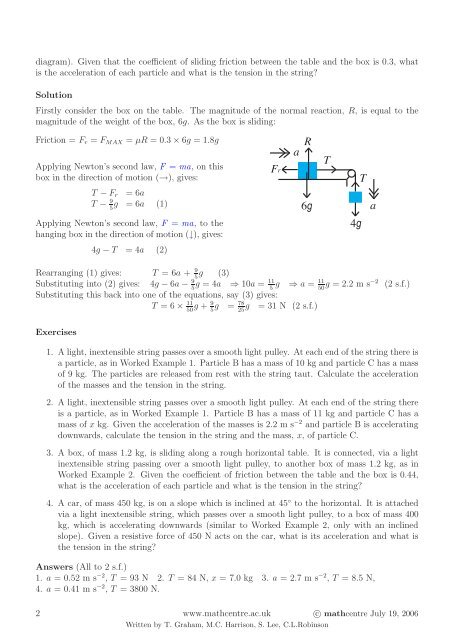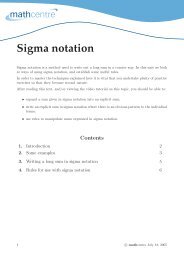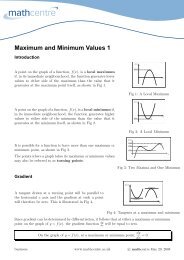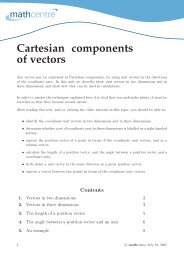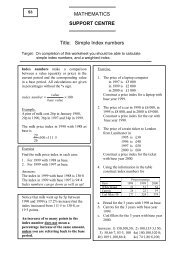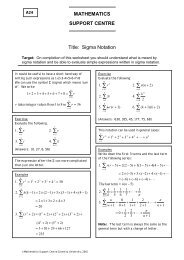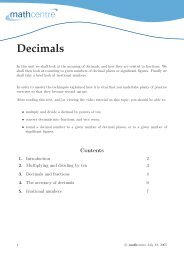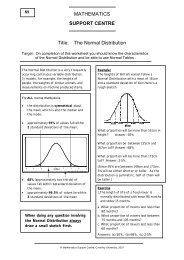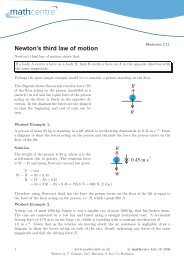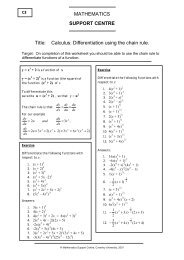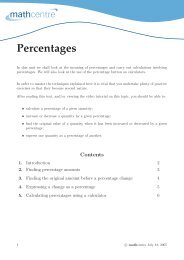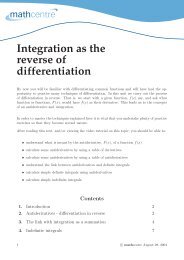Pulleys
Pulleys
Pulleys
You also want an ePaper? Increase the reach of your titles
YUMPU automatically turns print PDFs into web optimized ePapers that Google loves.
diagram). Given that the coefficient of sliding friction between the table and the box is 0.3, what<br />
is the acceleration of each particle and what is the tension in the string?<br />
Solution<br />
Firstly consider the box on the table. The magnitude of the normal reaction, R, is equal to the<br />
magnitude of the weight of the box, 6g. As the box is sliding:<br />
Friction = F r = F MAX = µR = 0.3 × 6g = 1.8g<br />
Applying Newton’s second law, F = ma, on this<br />
box in the direction of motion (→), gives:<br />
T − F r = 6a<br />
T − 9 g = 6a (1)<br />
5<br />
Applying Newton’s second law, F = ma, to the<br />
hanging box in the direction of motion (↓), gives:<br />
Fr<br />
a<br />
R<br />
6g<br />
T<br />
4g<br />
T<br />
a<br />
4g − T = 4a (2)<br />
Rearranging (1) gives: T = 6a + 9g (3) 5<br />
Substituting into (2) gives: 4g − 6a − 9 11<br />
g = 4a ⇒ 10a = g ⇒ a = 11g<br />
= 2.2 m 5 5 50 s−2 (2 s.f.)<br />
Substituting this back into one of the equations, say (3) gives:<br />
. T = 6 × 11g<br />
+ 9g = 78 g = 31 N (2 s.f.)<br />
50 5 25<br />
Exercises<br />
1. A light, inextensible string passes over a smooth light pulley. At each end of the string there is<br />
a particle, as in Worked Example 1. Particle B has a mass of 10 kg and particle C has a mass<br />
of 9 kg. The particles are released from rest with the string taut. Calculate the acceleration<br />
of the masses and the tension in the string.<br />
2. A light, inextensible string passes over a smooth light pulley. At each end of the string there<br />
is a particle, as in Worked Example 1. Particle B has a mass of 11 kg and particle C has a<br />
mass of x kg. Given the acceleration of the masses is 2.2 m s −2 and particle B is accelerating<br />
downwards, calculate the tension in the string and the mass, x, of particle C.<br />
3. A box, of mass 1.2 kg, is sliding along a rough horizontal table. It is connected, via a light<br />
inextensible string passing over a smooth light pulley, to another box of mass 1.2 kg, as in<br />
Worked Example 2. Given the coefficient of friction between the table and the box is 0.44,<br />
what is the acceleration of each particle and what is the tension in the string?<br />
4. A car, of mass 450 kg, is on a slope which is inclined at 45 ◦ to the horizontal. It is attached<br />
via a light inextensible string, which passes over a smooth light pulley, to a box of mass 400<br />
kg, which is accelerating downwards (similar to Worked Example 2, only with an inclined<br />
slope). Given a resistive force of 450 N acts on the car, what is its acceleration and what is<br />
the tension in the string?<br />
Answers (All to 2 s.f.)<br />
1. a = 0.52 m s −2 , T = 93 N 2. T = 84 N, x = 7.0 kg 3. a = 2.7 m s −2 , T = 8.5 N,<br />
4. a = 0.41 m s −2 , T = 3800 N.<br />
2 www.mathcentre.ac.uk c○ mathcentre July 19, 2006<br />
Written by T. Graham, M.C. Harrison, S. Lee, C.L.Robinson


